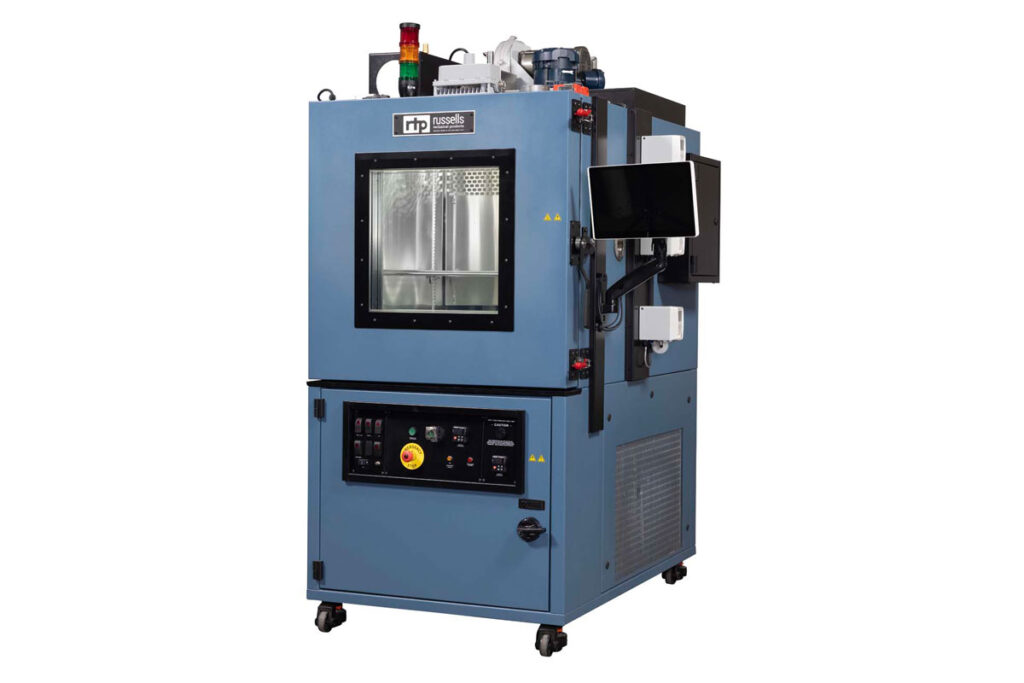Battery Test Chambers
Our battery test chambers are equipped with safety features conforming to industry safety standards enabling testing to a variety of conditions and specifications including extreme temperature cycling, humidity, vibration, and/or altitude. Our environmental chambers for battery testing are used in a wide range of battery testing applications including lithium ion, battery packs, lead acid batteries, modules, and more. Whether you need a reach-in chamber for smaller applications, a walk-in, or a complete drive-in, our battery test chambers are designed to safely test to your exact specifications.
Expertise
Our expert application engineers will work with you to select the right chamber and features to meet your specific testing needs safely and efficiently.
What are Battery Test Chambers?
Our battery test chambers are compatible with testing EV battery packs and complete systems, or smaller individual cells and modules. Our battery test systems for electrical energy storage conform to industry safety standards, giving you peace of mind in safe testing practices for your facilities and personnel. Because failure of battery systems can occur during temperature and humidity testing, our battery test chambers are equipped with safety features relative to the specific EUCAR hazard safety level in your testing. Contact us today for more details and allow our experienced team to guide you to the right battery testing solution.
Specialized Environmental Chambers For Battery Testing
Available Features
- Light and audible alarm warning
- Overheat protector with sensor
- Drip tray for electrolyte leakage
- Cooling mechanism, for sample plate (liquid nitrogen)
- Gas detection sensors and alarms
- Pressure relief vent (low flow)
- Auto-reset blow-out port
- Reinforced door latches
- Port restraint to secure silicone port plug
- Intrinsic barriers
- Fire detection/suppression systems
- Purging system with inert gas
- Minimal spark interior construction
- Electric door lock
Hazards of Battery Testing
The EUCAR Hazard Levels define the outcome of cell level safety testing. These levels are normally used to describe the outcome of tests such as overcharge as part of the cell specification.
| Description | Classification Level & Effect | |
|---|---|---|
| 0 | No Effect | No effect, no loss of functionality |
| 1 | Passive protection activated | No defect; no leakage; no venting, fire or flame; no rupture; no explosion; no exothermic reaction or thermal runaway. Cell reversibly damaged. Repair of protection device needed. |
| 2 | Defect/damage | No leakage; no venting, fire or flame; no rupture; no explosion; no exothermic reaction or thermal runaway. Cell irreversibly damaged. Repair needed. |
| 3 | Leakage, mass change < 50% | No venting, fire or flame; no rupture; no explosion. Weight loss < 50% of electrolyte weight (electrolyte = solvent + salt |
| 4 | Venting, mass change ≥ 50% | No fire or flame; no rupture; no explosion. Weight loss ≥ 50% of electrolyte weight (electrolyte = solvent + salt). |
| 5 | Fire or flame | No rupture; no explosion (i.e. no flying parts). |
| 6 | Rupture | No explosion, but flying parts of the active mass. |
| 7 | Explosion | Explosion (i.e. disintegration of the cell). |
The EUCAR hazard levels are also used to describe the safety level for cell test chambers. However, you also need to understand the capacity of the cells being tested and the likely hazard level in order to determine if the chamber can contain the cell if it does fail. A large capacity cell being tested with a likely hazard level 4 result could create an overpressure in a small test chamber, the failure of the test chamber could itself endanger personnel.
Types of Battery Tests
Safety standards for lithium-ion batteries under EUCAR, UL, CSA or IEC describe the requirements for the construction and testing of Lithium-Ion batteries. Different types of battery tests involve potentially destructive tests that can lead to hazards like fire and explosion, which can compromise safety.
| Test Description | Passing Criteria |
|---|---|
| Short-Circuit Test | No explosion or fire |
| Abnormal Charging Test | No explosion or fire |
| Forced-Discharge Test | No explosion or fire |
| Shock Test | No explosion or fire or leakage |
| Vibration Test | No explosion or fire or leakage |
| Heating Test | No explosion or fire |
| Temperating Cycling Test | No explosion or fire |
| Low Pressure (Altitude Simulation) Test |
No leakage |
